A new report found that nearly 1/3 of temporary immigrants earn only $12 per hour or less, or about half of the legal wage! 46% of the hourly pay is no more than $15 per hour!
The exploitation of non-PR/ citizens in Australia may be more serious than we thought, and the exploitation of these foreign workers seems to have become Australia's "norm and habit".
A hidden underclass.
UNSW and UTS surveyed more than 4000 temporary immigrants from 107 countries, mainly international students (2392) and backpackers (1440), the first similar report in Australia and so far targeted at international students. The exploitation of backpackers and other temporary immigrants, the most systematic and complete report.
More than nine hundred thousand of temporary immigrants make up more than 10% of the Australian labour market, which is a very important component, but their situation is not very good, even very bad!
"this survey actually shows that there are hidden underclass groups in Australia. Their main components are international students and backpackers, and their wages are well below the minimum standard."
The national minimum hourly wage is now $18.29 per hour, or $694.9 / 38 hours per week (all pre-tax). However, the survey found that among the interviewees:
: 1/3 backpackers earn less than $12 per hour and close to 50 per cent do not exceed $15 per hour;
: 1/4 students earn less than $12 per hour and 43 per cent do not exceed $15 per hour;
: equivalent to three out of every five temporary migrants (about 58 per cent) suffering from low-paid jobs;
: more than half of the respondents on temporary visas were below the minimum wage, with a maximum distribution of $10 to 12;
: more than 60 per cent of respondents holding travel visas are below the minimum wage, with a maximum distribution of $15 / 17 (illegal employment?);
: less than 25 per cent of respondents holding 457 were below the minimum wage, with a maximum distribution of $10 to 12;
: more than 60 per cent of respondents holding working vacation visas were below the minimum wage, with a maximum distribution of $10 to 12;
* about 65% of the student-signed respondents were below the minimum wage, the highest in all categories, with a maximum distribution of $15 to 17.
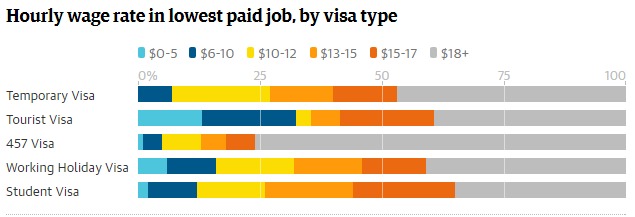
There are all kinds of industries.
Professor Berg, who took part in the survey, said that exploitation did not just occur in agriculture. "it is a common phenomenon, found in 12 different industries, and is more prevalent and serious in food services and agriculture, such as restaurants and takeout shops," he said. Pick fruit. "
: 31 per cent of those engaged in vegetable and fruit harvesting or other farm jobs earn a maximum hourly salary of only $10 per hour;
: $1/7 per hour or less;
An hourly salary of $0 / 5 is available for farm work up to
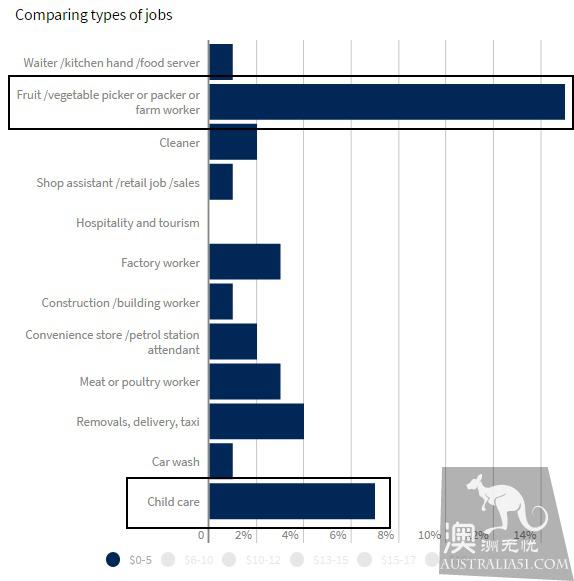
An hourly salary of $6 / 10 is available for car washing at most.
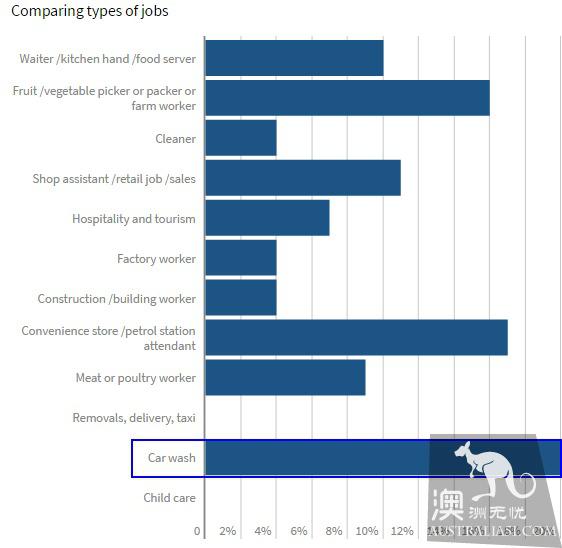
$10 per hour for up to $10 per hour in child care
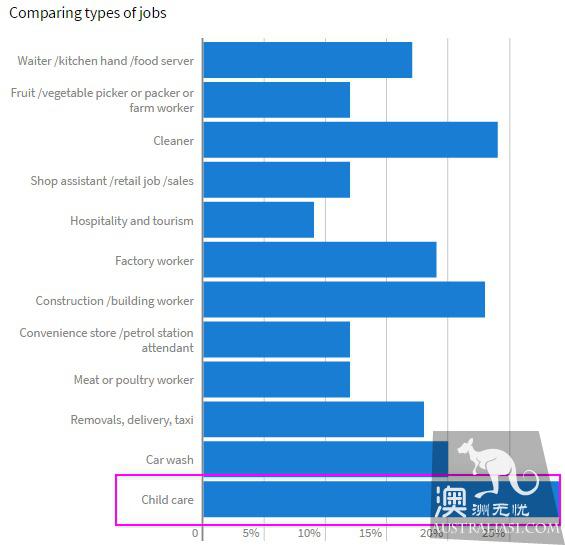
An hourly salary of $13 / 15 is also available for car washing at most.
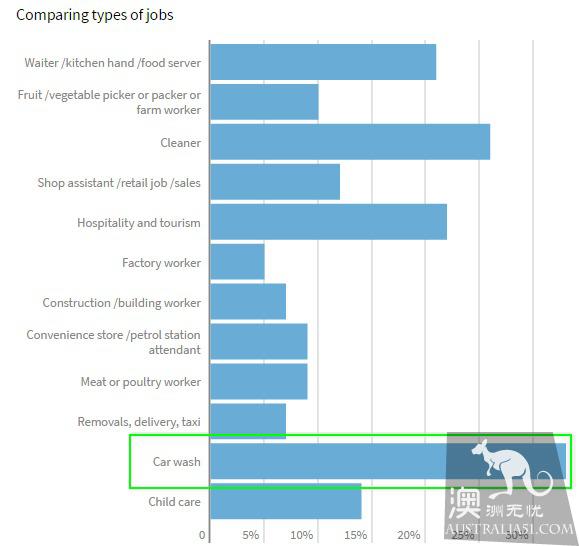
$15 per hour to work at convenience stores / gas stations

At least $18 per hour is more of a construction worker.
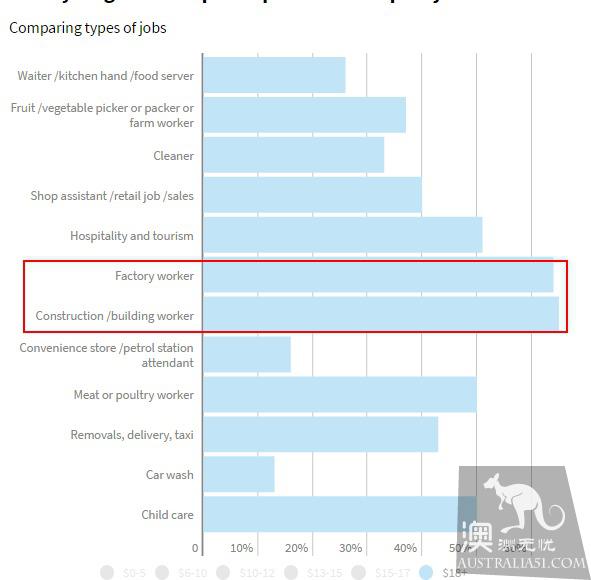
(image from SMH, above data does not include 457 holders)
China, Vietnam and other Asian countries are lower.
The survey also wrote that temporary visa holders from certain countries had a particularly difficult situation. Employees in Asian countries, including China and Vietnam, receive lower wages than those from North America, the UK and Ireland, and most Chinese workers receive cash wages.
* with an hourly salary of $6 / 10, the largest number from mainland China;
: some 23 per cent of temporary immigrants from mainland China earn less than $10 per hour, the lowest percentage above $18, but almost 33 per cent are paid between $15 and 17 per hou
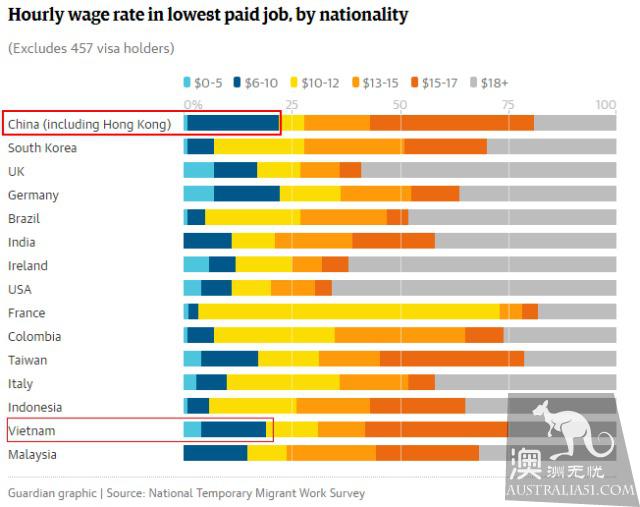
(image from theguardian, chart data does not include 457 holders)
They all know it in their hearts.
Investigators say a common misconception is that exploitation is caused by temporary immigrants who do not know the minimum wage. But they found that most temporary immigrants knew they were underpaid, but few expected or believed to receive a standard minimum hourly wage.
One backpacker frankly said he was only working to meet the visa extension requirements, and how much he was paid was not important, anyway, but only for the time being. "if you look at these recruitment sites every day, you'll find that farm jobs are also very competitive." When supply exceeds demand, employers are naturally given the opportunity to exploit it.
Laurent Van Eesbeeck, 25, worked just $5 an hour picking tomatoes in Bundaberg, Queensland, in June, and $60 a day in Caboolture, north of Brisbane, in August!
There are also forms of exploitation.
The survey also found that 91 respondents said their passports had been confiscated by employers or accommodation providers, mainly in the food service industry, which was illegal in any industry or under any circumstances.
A further 173 people, or 5 percent of the total, had to pay A $1000 in deposits before they got a job, and 112 said employers asked them to return some of their money in cash after they got paid.
Eighty percent of the respondents were paid in cash!
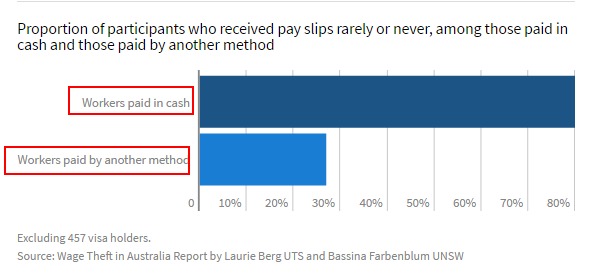
(image from SMH)
Seventy-four percent of those earning less than $12 per hour and those who never or rarely received payslip, were 34 percent higher than those earning more than $12 an hour!
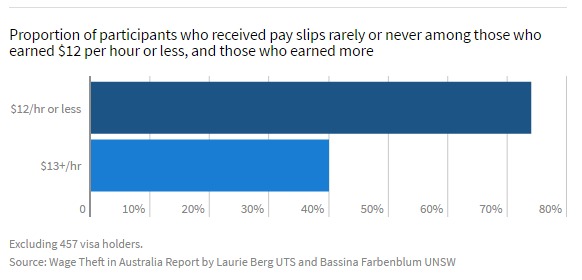
(image from SMH)
Professor Berg said the exploitation of temporary immigrants not only violates their rights, but also lowers wages for other workers in the industry, and exploitative employers gain unfair competitive advantages.
Professor Berg hopes the survey will provide strong evidence for goverment, companies and other relevant organizations to truly address the problem.
"the goverment wants to focus on food services and horticultural harvesting, and workers' organizations need to provide more resources to help temporary immigrants."
She hopes that all aspects of the links can work together to be responsible.
For temporary immigrants, this may be a more accurate reflection of the actual wage and income situation. The exploitation of overseas students, backpackers and even new immigrants in the Australian workplace has long been an old-fashioned issue. Really hope again and again remind, can have the substantive effect!